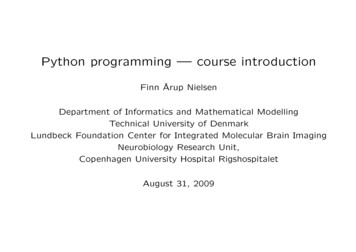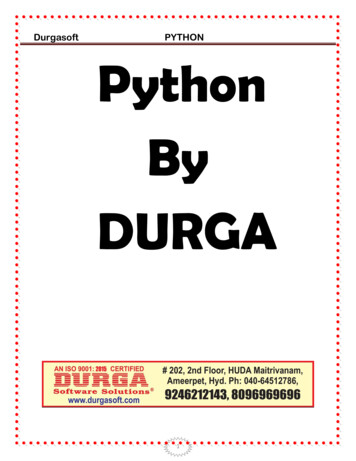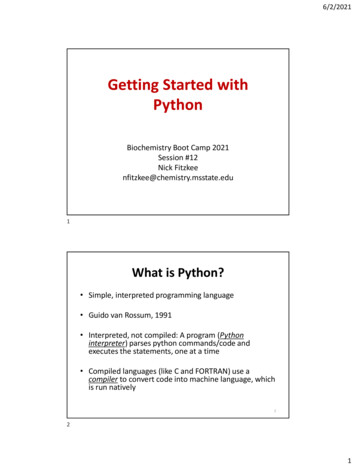
Transcription
Introduction to PythonFilippo Aleotti, Università di BolognaCorso di Sistemi DIgitali MStefano Mattoccia, Università di Bologna
What is PythonPython is a programming language originally developed by Guido van Rossumand now supported by a large community.It is object oriented and dynamically typed, particularly suited for scripting but itcan be used also for developing applications (web, GUI, etc)Nowadays, it is largely adopted by researchers since it is easy to learn and use,allowing to fast prototype applications and tests
What is PythonProgramming languages trend (last updated 14/10/2019) on StackOverflow
What is PythonSome companies that uses Python in their stack (according to stackshare)
What is PythonUnfortunately, there exists two main versions of Python: Python 2.x and Python 3.xDespite their are quite similar, a program written using Python 2.x may not work forPython 3.x and viceversaMost of libraries and frameworks (e.g., TensorFlow, PyTorch, NumPy and manymore) are available for bothIn this course we will use Python 3.x since Python 2.x won’t be supported anymorestarting from 2020, but many programmers are still using it
Hello, WorldLet’s write our first application, considering the case of the traditional “Hello, world!”.Java source codeHow to run the codejavac HelloWorld.java && java HelloWorldPython source codeHow to run the codepython hello world.py
Data typesAs we said before, Python is a dynamically typed language. This means that weare not forced to explicit the type of each variable, since the compiler is smartenough to understand the type by himself.Notice also that the ; character is no more required at the end of the line
Data typesPrimitive types of the language are integer, float, strings and boolean
Data types and primitives: castingSometimes we need to change from a type to another.To do so, we can cast the type (of course paying attention, otherwise an exceptionwill be raised)
Data types: string formattingLot of times we need to format a string to improve the readabilityWe can format our string using the format method of stringsbut we can even apply more complex operations, such as reducing the numbers ofdecimalsMore informations are available here
Data types: math with integers and floatsMathematical operations are performed as usual
Data types: stringsStrings are sequences of charactersThey do not support item assignment or mixing characters with int or float
Data types: tuplesPython offers more complex data structures to handle data. Some of the mostimportant are tuples, lists and dictionariesTuples are immutable list of values comma-separatedThey can be accessed by indexBut the values cannot be changed (otherwise TypeError will be raised)
Data types: listsIf you plan to change your data, a better option consist in using lists instead oftuples.As for tuples, we can get elements by indexBut, differently from tuples, lists are editable
Data types: dictionariesDictionaries allow to store key-value couples
StatementsAs for other programming languages, Python exposes if statement forconditions and for and while to iterate.Using the if, we can execute a set of instructions a given a certain condition
Statements: ifNOTE: you can notice that the instruction to execute are indented with respectto the condition. In Python indentation is mandatory and if not respected thecompiler will throw an exception.You are free to indent with tabs or spaces, but you can not use both in the samescriptIndenting a block is the equivalent of wrapping a set of instructions with { } inJava
Statements: forFor loops are useful to do some operations N timesWe can iterate also over collections
Statements: whileWhile loop is used to continue iterating until a given condition is no moreverifiedThis script will print “apple is at index 3”
FunctionsIn order to improve the readability but also the reusability of your code, it is agood practice to encapsulate a set of instruction inside a function. Thisfunction may be called both from the same and even also from other scripts.Functions are defined using the def keywordIn this case, x and y are arguments of the dot function
Functions: default argumentsIn Python, we can assign default values to arguments of the functionWe can also change a specific set of values
ScopesThe scope of a variable defines its visibility: it depends by where the variablehas been defined and influence how we can use that variableIn Python we are not forced to declare always a variable (even it may be a goodpractice, to improve the readability of the code)In this case b True since the condition x 3 is verified, but with x 1 the programwould raise NameError: name 'b' is not defined
ScopesAll the variables declared inside a function are local, so they are not visibleoutside that functionVariables defined in global scope are visible inside local ones
ScopesGlobal variables are visible but not editable inside a functionUsing the global we are able to modify global variablesIf we had forgotten the global, the program would have raisedUnboundLocalError: local variable 'x' referenced before assignment
ObjectsIn OOP, objects wrap data and methods to handle with a specific element of thedomain.For instance, in our exam-assistant application we can model a student as anobject to keep trace of all the properties of a particular student (e.g., his ID) andspecify methods valid for all the studentsIn particular, Student will be a class in our application, while the specificstudent Filippo Aleotti (with name “Filippo Aleotti” and ID “0123456”) is anobject (i.e., an instance of class Student)
ObjectsLet’s create the class Student and our first object of that class
ObjectsIn particular: In Python, by default all objects inherit by object We defined the constructor of our object using the reserved methodinit .The keyword self is like the this operator in Java, allowing to refer to theobject. In the constructor we set the two properties (name and id) of object
Objects We defined the method introduce yourself We then created an instance of class Student and invoked his methodintroduce yourself
Objects: defaults in constructorIn Python you cannot define multiple constructors for your class, but you arefree to use default values
Objects: properties definitionYou are free to define wherever you want properties of your object
Objects: inheritanceInheritance is useful to recycle parent’s methods and properties, avoiding torewrite already defined pieces of codeYou can access to parent’s method using the super keywordMultiple inheritance is allowed (but you can avoid it exploiting the sameconsideration used for languages in which it is forbidden)
ImportsSometimes we have to import functions or objects created by us in a differentfile (e.g., utils) or even third-party libraries (e.g., NumPy, TensorFlow)To do so, Python offers the import keywordNOTE: Third-party libraries firstly have to be installed on yoursystem/environment. Package manager (Pip, Anaconda etc) can help you totackle this task
Some examples
InstallationBefore we start to code, we need to install Python 3.x if not already installed on ourmachineLinux machines already have Python, while Mac and Windows users have todownload and install it respectively from here and hereIt is not mandatory, but for this course we suggest to use Ubuntu when it ispossible: some installations (e.g., TensorFlow) may be simpler than using othersolutions.
Creation of a virtual environmentEven if your system has Python already installed, it is a good practice to create avirtual environment, since it allows to install dependencies and packages withoutcreate conflicts with other environments (like in a sandbox).venv is the name of the new environment that will be created, while the lastcommand activate the env
PipIn the previous slide, we ran the command “pip3 install virtualenv”Pip (for Python 3.x is Pip3) is a package manager: it allows to install modules andpackages available in a storeFor instance, if we need OpenCV, which is a wide use open source computer visionand machine learning library, we need to runIn the PyPI store you can search if the package you need is available
Exercise 1Given the list [0,1,0,2,2,1,2,1,0,0,2,1,1], store the frequency of each value in adict, where the key is the value.
Exercise 1In this solution, we used the list comprehension to iterate over the list withremaining valuesIt returns a new list, made up by those values that satisfies a given condition
Exercise 2We stored into the file temperatures.txt many of temperatures (expressed incensus degrees) for a set of places. Each line contains the values, separated byspace, for a specific place.Find the maximum and minimum temperature for each placeFind the global maximum and the minimum temperature
Exercise 2: tips First of all, we need to read the values from the temperatures.txt fileIn Python, we can manage with files using the with statementThe with block masks the opening and the closing of the fileIn the example we opened the file temperatures.txt in read modality (‘r’), getting backthe file pointer as f. Then, we use f to store each line of the file into a listOther modalities are write (‘w’), read-write(‘rw’), read binary (‘rb’) and write-binary(‘wb’)
Exercise 2: tips sys.float info.max and sys.float info.min return respectively the maximum andthe minimum float values We need to remove the end-line character. The function strip() of string do thetask We read strings from the file, so we need to cast them into float values if wehave to perform
Exercise 2: solution
Exercise 2: another solutionIn this solution we exploit the built-in functions min and max to find the minimumand maximum of a collection.Moreover, we used the map function to apply an operation(in our case, the casting)to each element of a collection
Introduction to Python Filippo Aleotti, Università di Bologna Corso di Sistemi DIgitali M Stefano Mattoccia, Università di Bologna. What is Python Python is a programming language originally developed by Guido van Rossum and now supported by a large community.









